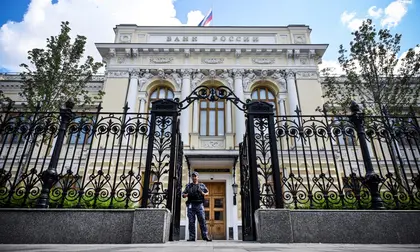In a landmark decision reached on Wednesday, May 8, European Union member states have agreed to allocate billions of euros from frozen Russian central bank assets to bolster Ukraine's defense capabilities and aid its post-war reconstruction.
This move comes as Moscow has made battlefield gains in recent months, exploiting its manpower and weapons advantage while Kyiv awaited critical new Western aid, more than two years into the war.
JOIN US ON TELEGRAM
Follow our coverage of the war on the @Kyivpost_official.
With Washington finally set to deliver on a long-stalled aid package, the European Union has also been under pressure to increase its support for Ukraine.
Leaders of the 27-nation bloc had already agreed in March to move forward with the proposal to utilize the frozen assets, which are expected to release around €3 billion ($3.3 billion) annually.
Announcing the agreement on X, the bloc's Belgian presidency stated that EU ambassadors had "agreed in principle on measures concerning extraordinary revenues stemming from Russia's immobilised assets."
🇺🇦 EU ambassadors agreed in principle on measures concerning extraordinary revenues stemming from Russia’s immobilised assets.
— Belgium in the EU (@BelgiuminEU) May 8, 2024
👉 The money will serve to support #Ukraine's recovery and military defence in the context of the Russian aggression.
These funds, it said, would "serve to support Ukraine's recovery and military defence in the context of Russian aggression," with the first tranche expected to be released in July.
EU Commission chief Ursula von der Leyen emphasized the significance of this decision, stating, "There could be no stronger symbol and no greater use for that money than to make Ukraine and all of Europe a safer place to live."

Ukraine's Future: The Path to Victory
I welcome today's political agreement on our proposal to use the proceeds from immobilised Russian assets for Ukraine.
— Ursula von der Leyen (@vonderleyen) May 8, 2024
There could be no stronger symbol and no greater use for that money than to make Ukraine and all of Europe a safer place to live. https://t.co/zGQMVAKAMt
The EU had frozen approximately €200 billion of Russian central bank assets held in the bloc as part of punishing sanctions imposed on Moscow following its invasion of Ukraine in February 2022.
However, simply confiscating this money and giving it to Ukraine was ruled out due to concerns about potential disruptions to international markets and the stability of the euro.
Instead, EU leaders settled on a plan to target the interest being paid on the frozen assets.
Under the agreement, which is to be submitted to EU ministers for formal approval, 90 percent of the interest will go to a central fund used to purchase weapons for Ukraine, known as the European Peace Facility, while the remaining 10 percent will go to the EU's separate Ukraine Facility.
The agreement also includes a provision for Belgium to transfer to Ukraine the entirety of the tax revenues generated by the profits from the frozen assets since the start of the war, totaling an additional €1.7 billion for Ukraine in 2024.
As part of the deal, the fees charged by Euroclear, the international deposit organization based in Belgium that handles around 90 percent of the frozen assets, have also been significantly reduced.
Euroclear's fee for handling the assets was slashed tenfold, to 0.3 percent of profits, as part of the agreement.
While the EU has made significant strides in supporting Ukraine, it has fallen short of its promise made last year to supply Ukraine with a million artillery shells by this month.
In an effort to expedite support, the EU has put forward a series of proposals aimed at arming Ukraine, including expanding lending to technologies useful for militaries, a move formally approved by the board of the European Investment Bank on Wednesday.
However, there are concerns that Europe is still not moving fast enough. Estonia's foreign minister, Margus Tsahkna, who is leading efforts to ramp up support, described Wednesday's agreement as a "first step" toward utilizing the full amount of frozen Russian assets.
The United States, meanwhile, recently approved a massive aid package of $61 billion for Ukraine, authorizing the president to confiscate and sell Russian assets to finance Ukraine's reconstruction. This idea is gaining traction among other G7 countries.
In total, an estimated $397 billion in Russian assets have been frozen by the West, including three-quarters in central bank assets, as well as yachts, real estate, and other property belonging to oligarchs close to President Vladimir Putin.
You can also highlight the text and press Ctrl + Enter






